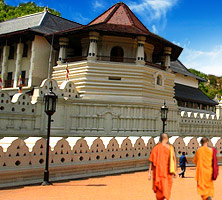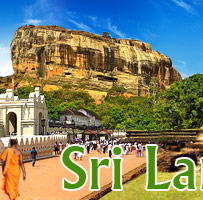Kandy-a major tourist destination-is also known as the cultural capital
of Sri Lanka. Nestled in the hills at an altitude of 488 m, it is located
at a distance of 115 km from Colombo.
Kandy has a rich history. It was originally known as Senkadagala pura
after a hermit named Senkada who lived there. Many of Sinhalese people
call it Mahanuwara meaning the Great City. The name Kandy was derived by
the colonial rulers from the word Kanda in Sinhala, meaning a hill. Kandy
was the stronghold of the Sinhalese kings, who promoted and protected the
local culture until the city fell to the British in 1815.
Today a bustling commercial city, Kandy is famous for the Kandy
Perahara-a huge cultural pageant that takes place in the month of July
or August. It is one of the most colorful processions of the world.
Thousands of drummers and dancers accompanying a parade of ornamented
elephants perform in the streets of Kandy. The leading tusker carries the
sacred tooth relic of Lord Buddha, while the spectators pay homage to it.
The procession moves along the streets for seven consecutive nights and
concludes on the day of the August full moon.
City Travel Guide
The Temple of Tooth:
Also known as Dalda Maligawa, it is one of
the most sacred Buddhist pilgrimage sites in the world. Here, one of the
Buddha's teeth is kept. The temple was built in the 17th century. A golden
canopy has been added recently. Daily rituals are performed three times a
day-at 4.30 a.m., 10.30 a.m., and 6.30 p.m. respectively.
Gadaladeniya Temple:
Built in 1344, the temple is situated on a
hilltop at a distance of 15 km from the town. The temple is inspired by
Dravidian architecture and gives a spectacular view of the surrounding
countryside.
Peradeniya Gardens:
The garden-a paradise for nature lover- was
built in 14th century during the reign of king Vikrama Bahu III. The
best-known attraction of the garden is the orchid House, which houses more
than 300 varieties of exquisite orchids. A spice garden located here gives
you a first hand account of the trees and plants used in the traditional
Ayurvedic medicine.
Embekke Temples:
This 14th century temple is famous for the
intricate wooden carvings dedicated to God Katargama. Almost the entire
structures of some wooden buildings are decorated with dancers, musicians,
wrestlers, legendary beasts and birds. Nearby are the ruins of an ancient
rest house with similar pillars carved in stone.
Lankatilaka Temple:
Lankatilaka temple dates back to 14th century.
It is built on the summit of a rock called Panhalgala. The temple provides
a magnificent panoramic view of the surrounding hills, paddy fields and
the diverse vegetation around it.
Knuckle Mountains:
The Knuckles range is about 90 square miles in
extent and is a detached block of the central highlands separated from the
main highlands by the the Dumbara Valley. There are 35 peaks rising to
more than 3000 feet (915 m) in the Knuckles range. It has a rich variety
of flora and fauna.
Hanthana Mountains:
Hanthana Mountains are spread on the outskirts
of Kandy and are a source of many rivulets and streams. They are an ideal
destination for the trekkers.
Udawatte Kele:
Udawatte Kele is a primeval forest located above
the Dalada Maligawa. It is also known as the Forbidden Forest of the Kings
of Kandy. It contains a variety of trees such as Talipot trees, cinnamon,
olive, rattan cane, betel, bo-trees, kitul palms, jak, mara, betelnut and
arecanut.
Hindu Shrines:
There are four Hindu shrines dedicated to Gods
Vishnu and Natha and Goddess Patthini in Kandy. Three of them are located
adjacent to the Temple of Tooth, while the fourth one is towards the town.
Buddhist Temples:
There are many Buddhist temples surrounding
Kandy. Famous among them are Malwaththa and Asgiri temples located on the
shores of the lake.
Kandy-the cultural capital of Sri Lanka- is a World Heritage Site and has number of tourist attractions.
Home: City Guide: Kandy










